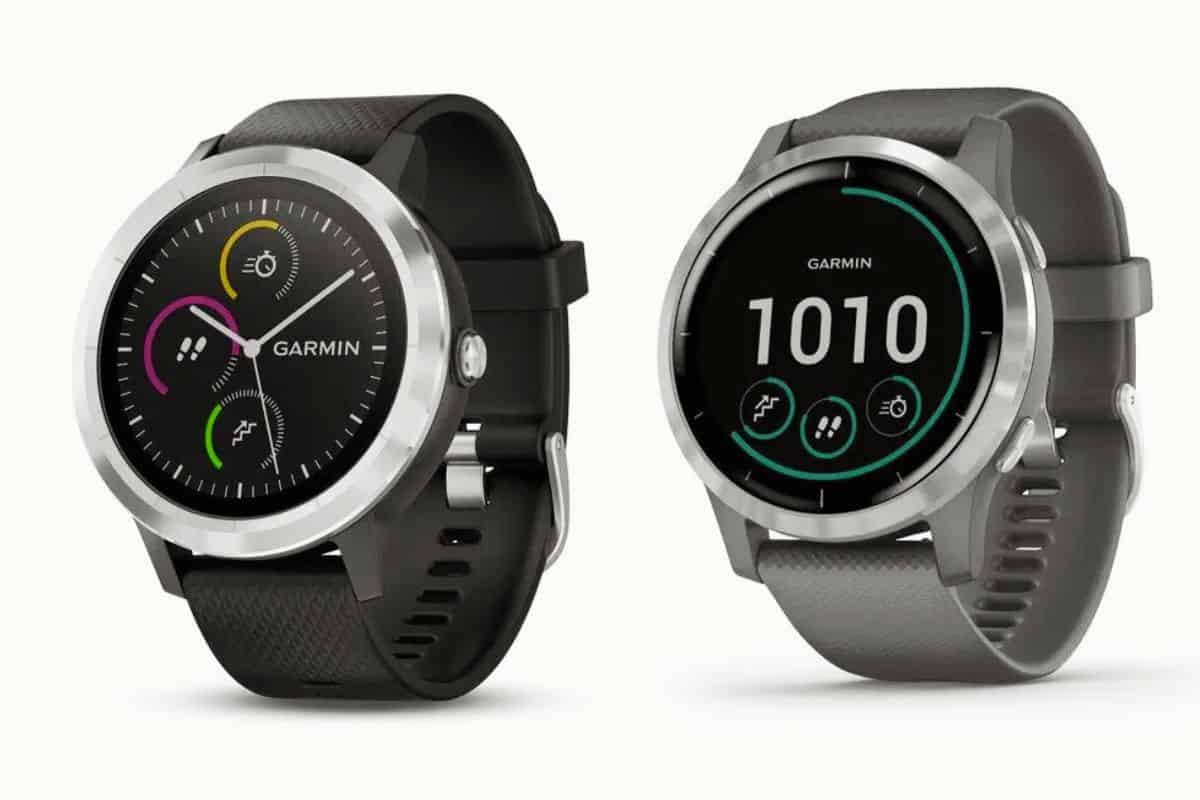When considering a smartwatch that caters to both your fitness and lifestyle needs, the Garmin Vivoactive series stands out.
- The Vivoactive 3 emerged as an impressive contender in the market with its sleek design, contactless payment solution, and a variety of sports apps. You enjoy the convenience of controlling music playback on your smartphone and tracking your typical fitness routine without the bulk of carrying your device.
- In contrast, the Garmin Vivoactive 4 builds upon the foundation laid by its predecessor, introducing new health and wellness features. You have the option to track a wider variety of activities and receive on-screen workout animations, which is a step up from what you can do with the Vivoactive 3. Additionally, if storing music directly on your device to listen without your phone is important to you, the Vivoactive 4 has that capacity, unlike the standard Vivoactive 3.
The choice between the more established Vivoactive 3 and the feature-rich Vivoactive 4 is significant, dependent not just on the specs but also on your specific needs and preferences.
Aspects such as band width, body volume, weight, and even charge time might influence your decision. With the Vivoactive 3 being lighter and thinner, it’s an option that appeals to those who prioritize a more streamlined device.
Meanwhile, if having the latest health-tracking technology motivates you more, the Vivoactive 4 could be your ideal fitness companion.
Design and Aesthetics

When comparing the Garmin Vivoactive 3 and 4, you’ll notice thoughtful enhancements in design, reinforcing both form and function.
These variations are evident in the materials used, the display quality, and the overall size and dimensions.
No products found.
Material and Build
The Garmin Vivoactive 4 maintains the premium build quality of the Vivoactive 3, featuring a durable stainless steel bezel which adds to the robustness and aesthetics of the watch.
Although both models have a fiber-reinforced polymer case, the Vivoactive 4 offers a slate finish option for a more sophisticated look.
Display Quality
Your viewing experience on the Vivoactive 4 is slightly improved with the 1.3-inch transflective memory-in-pixel (MIP) display on the larger size, while the Vivoactive 3 comes with a 1.2-inch display of the same type. Both provide good readability in various lighting conditions, ensuring you can see your stats clearly at a glance.
Size and Dimensions
The Vivoactive 4 is available in two sizes: the 45mm and the smaller 40mm, accommodating different wrist sizes and preferences.
The Vivoactive 3 comes in a single 43.4mm size, which sits comfortably between the two Vivoactive 4 models. Here’s a quick comparison for clarity:
| Feature | Vivoactive 3 | Vivoactive 4 (45mm) | Vivoactive 4 (40mm) |
|---|---|---|---|
| Display Size | 1.2 inches | 1.3 inches | 1.1 inches |
| Unit Size | 43.4 x 43.4 x 11.7 mm | 45.1 x 45.1 x 12.8 mm | 40.0 x 40.0 x 12.7 mm |
The design choices of the Vivoactive 4 will likely appeal to you if you’re looking for a more customizable and size-inclusive fitness watch.

Health and Fitness Tracking Features
The Garmin Vivoactive series elevates your fitness tracking experience with specialized features and comprehensive health monitoring.
The Vivoactive 4 significantly expands on the capabilities of the Vivoactive 3, especially in health and wellness tracking.
Heart Rate and Stress Monitoring
Your Garmin Vivoactive 4 continuously tracks your heart rate, providing valuable insights into your fitness levels and calorie burn.
Both watches offer stress tracking functions, helping you understand your body’s response to potential stressors.
With the Vivoactive 4, you get the added benefit of Pulse Ox to gauge blood oxygen saturation, which can enhance sleep tracking and altitude acclimation.
Advanced Tracking Functions
In terms of sensor technology, both the Vivoactive 3 and Vivoactive 4 come with an accelerometer and gyroscope essential for recording movements during your activities.
The Vivoactive 4 goes further, introducing respiration tracking which can contribute to understanding your overall health and wellness in combination with other stats.
- Vivoactive 3:
- Heart Rate
- Stress Level
- Vivoactive 4:
- Heart Rate
- Stress Level
- Pulse Ox
- Respiration
Workout and Activity Profiles
No products found.The Vivoactive 3 already allows you to track a broad range of activities including running, swimming, yoga, and pilates.
Vivoactive 4 extends these offerings, adding on-screen workout animations for various exercises and the ability to track your hydration.
It caters particularly well to active individuals who require detailed feedback on their fitness and health, with a dedicated body battery feature that monitors energy levels to optimize your workout and rest periods.
Activities on both models:
- Running
- Swimming
- Yoga
- Pilates
Vivoactive 4 exclusive activities/features:
- On-screen workouts
- Hydration tracking
- Energy monitoring (Body Battery)
- Keeps track of your energy levels, Pulse Ox (this is not a medical device and is not intended for use in the diagnosis or monitoring of any medical condition), respiration, menstrual cycle, stress, sleep, estimated heart, hydration and more
- Easily download songs to your watch, including playlists from Spotify, Amazon music or Deezer (may require a premium subscription with a third party music provider), and connect with headphones (sold separately) for phone free listening
- Record all the ways to move with more than 20 preloaded GPS and indoor sports apps, including yoga, running, swimming and more
- Get easy to follow, animated workouts right on your watch screen, including cardio, strength, yoga and Pilates
- Battery life: Up to 8 days in smartwatch mode; Up to 6 hours in GPS and music mode
Smartwatch Functionality
In the realm of smartwatch functionality, the Garmin Vivoactive series excels at enhancing your daily life with seamless notifications and robust entertainment options, along with navigation features that keep you connected wherever you go.
Notifications and Smartphone Integration
Your Garmin Vivoactive 3 or 4 serves as an extension of your smartphone, alerting you to incoming notifications.
Both models support Bluetooth connectivity which allows you to receive smartphone notifications directly on your wrist. This means you can stay informed of calls, texts, and app alerts without needing to pull out your phone.
Alongside these features, the Garmin Vivoactive 4 enables NFC, which complements the Garmin Pay function for contactless payments, something the Vivoactive 3 lacks.
Music and Entertainment
When it comes to music and entertainment, the Vivoactive 4 offers onboard music storage, allowing you to download songs and playlists from services like Spotify, Deezer, and Amazon Music.
This means you can enjoy your favorite tracks directly from your wrist, and with Bluetooth headphones, no phone is necessary during your workout. The Vivoactive 3, in contrast, can control music playback on your smartphone but does not have storage for music.
Navigation and Connectivity
Navigation is paramount in a smartwatch, and both Vivoactive 3 and 4 include GPS capabilities, ensuring accurate tracking of your outdoor activities.
The newer Vivoactive 4 expands on this with a built-in compass and enhanced navigation features, offering you better guidance and location tracking.
Both models connect to Wi-Fi for updates and syncing data with the Garmin Connect app, ensuring your fitness milestones and daily metrics are recorded and analyzed.
Additionally, they provide you with real-time weather updates, keeping you equipped for the day ahead.
Battery Life and Charging

When choosing between the Garmin Vivoactive 3 and the Vivoactive 4, battery life is a critical aspect you should consider.
Garmin Vivoactive 3:
- Battery life: Up to 7 days in smartwatch mode
- Charge time: Approximately 1.5 hours to fully charge
Garmin Vivoactive 4:
- Battery life: Up to 8 days in smartwatch mode
- You’ll enjoy 1 day longer battery life compared to the Vivoactive 3.
- Charge time: It takes around 1 hour to reach a full charge, which is 0.5 hours less than the Vivoactive 3.
Here’s what you need to know about the charging aspect of both devices:
- Both devices utilize a USB charging cable that connects to the port on the watch.
- The Vivoactive 4 has a shorter charge time, which means less waiting around for a full recharge.
- The actual battery life for either device is dependent on usage—GPS, wrist-based heart rate, smartphone notifications, and music playback can all decrease battery longevity.
Keep the above points in mind when evaluating both devices’ suitability for your lifestyle and charging convenience.
The Vivoactive 4 provides a slight edge in terms of less frequent charging needs, which could be pivotal for those with an active lifestyle or longer workout sessions.
Compatibility and Integrations
When choosing between the Garmin Vivoactive 3 and Vivoactive 4, your experience will be largely influenced by how each device integrates with your daily tech ecosystem.
Both watches offer seamless connectivity options, but there are specific nuances you should be aware of.
Compatibility With iOS and Android

Both the Garmin Vivoactive 3 and Vivoactive 4 are designed to work well with iOS and Android smartphones.
This cross-platform compatibility ensures you can receive notifications and sync your fitness data irrespective of your phone’s operating system.
- Android: You can expect robust integration, with features such as notifications, music controls, and app synchronization.
- iOS: Similarly, iOS users will find a cohesive experience, though some features, like replying to messages, may be limited compared to the Android integration.
Third-Party App Support
A significant aspect of the Garmin ecosystem is its third-party app support, which enhances the functionality of your watch.
- The Vivoactive 3 and 4 support downloading of apps from the Garmin Connect IQ store, where you can find a variety of third-party applications to extend your watch capabilities.
- Both watches allow you to connect to sports apps, smart home apps, and utility apps, among others, but the Vivoactive 4 offers a couple of additional fitness-related integrations not found on the Vivoactive 3.
Safety and Additional Features
Garmin’s Vivoactive series prioritizes your safety and adds functionality to enhance your physical activities. Each model comes with its own set of advanced features designed to assist you in various situations.
Incident Detection and Safety
Your Garmin Vivoactive 4 is equipped with incident detection features that can provide peace of mind during outdoor activities. If an incident is detected, your watch can send an automatic message to your emergency contacts, provided you have your smartphone paired and with you.
- Incident Detection: Available on Vivoactive 4
- Emergency Contacts: Requires paired smartphone
Water resistance is a crucial aspect of any fitness tracker, and the Garmin Vivoactive series doesn’t disappoint. Both models carry a 5 ATM rating, meaning they can withstand pressures equivalent to a depth of 50 meters.
- ATM Rating: 5 ATM for Vivoactive 3 and 4
Swim Tracking and Water Resistance
When you’re swimming, your Garmin Vivoactive watches deliver comprehensive swim tracking capabilities. They are also built to endure constant immersion and exposure to water.
- Swim Tracking
- Track your swim workouts with metrics like distance, pace, stroke count, and SWOLF score.
- Water Resistance
- Vivoactive 3: Water-resistant
- Vivoactive 4: Water-resistant, enhanced swim tracking features
Remember, while both models are designed to handle submersion, the water resistance may decrease over time due to wear and tear, so always handle your device with care.
- Keeps track of your energy levels, Pulse Ox (this is not a medical device and is not intended for use in the diagnosis or monitoring of any medical condition), respiration, menstrual cycle, stress, sleep, estimated heart, hydration and more.Operating temperature range :From -20º to 60ºC (from -4º to 140ºF)
- Easily download songs to your watch, including playlists from Spotify, Amazon music or Deezer (may require a premium subscription with a third-party music provider), and connect with headphones (sold separately) for phone-free listening
- Record all the ways to move with more than 20 preloaded GPS and indoor sports apps, including yoga, running, swimming and more. Get easy-to-follow, animated workouts right on your watch screen, including strength, cardio, yoga and Pilates
- Fits wrists with a circumference of 110-175 millimeter
- Battery life: Up to 7 days in smartwatch mode; Up to 5 hours in GPS and music mode
Pricing and Value
When considering the Garmin Vivoactive 3 versus the Vivoactive 4, your budget plays a crucial role. The Vivoactive 3 generally comes at a lower price point, making it an appealing choice if your budget is tight.
In contrast, the Vivoactive 4, as the newer model, often carries a higher price tag but also includes advanced features that may justify the extra expense.
The value you get from either watch depends on your usage:
- If you need basic fitness tracking and smartwatch features, the Vivoactive 3 offers substantial value for a more affordable cost.
- For those seeking newer health-tracking technology and additional features, the Vivoactive 4 provides increased value due to its enhanced capabilities.
Keep in mind, prices can fluctuate based on sales and promotions, so it’s worthwhile to compare current offers before making your decision.
| Feature Comparison | Garmin Vivoactive 3 | Garmin Vivoactive 4 |
|---|---|---|
| Music Storage | Controls only | Internal storage |
| On-board GPS | Yes | Yes |
| Heart Rate Monitoring | Yes | Yes (advanced) |
| Body Battery Energy Monitoring | No | Yes |
| Pulse Ox Sensor | No | Yes |
| Price Range (Approx.) | Lower | Higher |
In terms of value, evaluate the extra features of the Vivoactive 4 and how they align with your specific needs to determine if the difference in price is warranted.
Remember, the most expensive option is not always the most valuable to you if the additional features exceed your requirements.
Choosing between the Garmin Vivoactive models ultimately depends on the balance you wish to strike between price and the specific functionalities you’ll use most.
Frequently Asked Questions
This section covers some of the most common inquiries you might have when deciding between the Garmin Vivoactive 3 and the Vivoactive 4.
What are the key differences in specifications between the Vivoactive 3 and the Vivoactive 4?
The Vivoactive 4 comes with a slightly larger display and more onboard storage for music compared to the Vivoactive 3, which can only control music playback on your phone. The Vivoactive 4 also introduces a pulse oximeter to measure blood oxygen saturation levels.
What improvements does the Vivoactive 4 offer over the Vivoactive 3?
Beyond hardware improvements, the Vivoactive 4 provides on-screen workout animations and an overall broader range of health tracking features such as respiration tracking, improved sleep monitoring, and the Body Battery energy monitor.
How do the battery lives of the Vivoactive 3 and Vivoactive 4 compare?
The Vivoactive 3 offers up to 7 days in smartwatch mode and 13 hours in GPS mode, while the Vivoactive 4 offers up to 8 days in smartwatch mode and up to 6 hours in GPS mode with music.
Considering the current technology, is the Vivoactive 3 still a good purchase?
Given its more affordable price point and a robust set of core features, the Vivoactive 3 remains a competitive option for those who don’t require the latest updates offered by newer models.
Is there a significant advantage to upgrading from the Vivoactive 3 to the 4 for active users?
For users who are actively involved in fitness and value the latest health tracking features, upgrading to the Vivoactive 4 offers advantages such as on-device music storage, animated workouts, and enhanced health monitoring tools.







